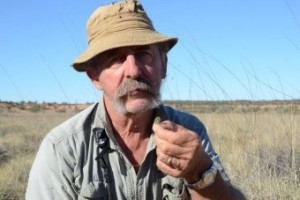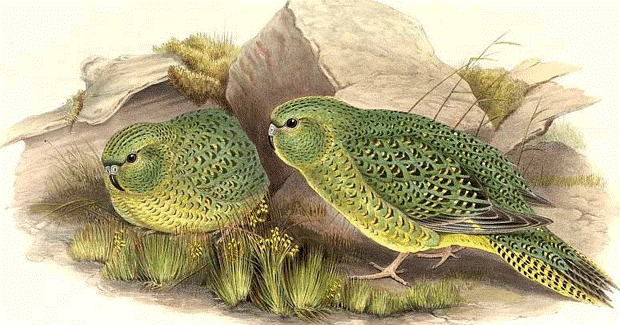An extraordinarily rare Australian bird, has important consequences for conservation
The Night Parrot has surely been amongst the most enigmatic birds of the world and deservedly the ‘holy grail’ for many birders. It originally had an extremely widespread distribution across a large proportion of Australia, but, for about the last one hundred years, there were no confirmed observations of the species. From this we would have concluded that the species was probably extinct, except for the fact that recently-dead specimens have turned up occasionally, most notably in 1999 and 2006. Perhaps encouraged by these latest records, many birders have invested large amounts of time and money in pursuit of this ghost-like bird. It has, for these people, been their ‘holy grail’. We have felt similarly, tried to keep informed regarding the species, and often fantasizing about having an encounter with it.

And now, amazingly, the Night Parrot has recently been ‘found’. John Young, a naturalist, after a quest lasting some 15 years, has succeeded in detecting the species in the same location on several occasions, observing it at least once, photographing it, and obtaining feather samples. The associated evidence has been examined by relevant experts, confirming the discovery and eliminating any lingering doubt. John Young has done it; he has found the ‘holy grail’.
But this does not end the quest for the Night Parrot; it just changes it, with the immediate task obviously being to assess, protect and conserve the newly discovered population of this species. Research is clearly warranted, addressing questions relating to the size and extent of the population, patterns of habitat-use and other behaviour, presence and perhaps relative absence of threats, and so on. A Plan of Management for the population will need to be developed, but integrated with the interests and activities of the associated land-owners. Steps, such as keeping the location as ‘secret’ as possible, will certainly be necessary to ensure that the birds are neither ‘loved to death’ by birders keen to ‘tick’ it off their list nor harmed by people with other motives. Ensuring that this population remains extant may not be easy. Of course, it is also possible that there are other populations yet to be discovered.
This new discovery of the Night Parrot could contribute to conservation through helping us to better understand the general ecosystem collapse that has occurred throughout the relatively arid parts of Australia. Across this vast area, a number of species of plants, birds, mammals, and other kinds of animals have suffered major declines, while cats and foxes, both introduced predators, have spread to the point of being near ubiquitous, and fire regimes have been greatly modified, especially by pastoralists keen to promote growth of plants suitable as food for their livestock. That those declines began and progressed with the arrival and expansion of European ‘settlement’ of Australia, especially in the early part of the 19th century, points to strong human-based impacts. Comparing locations where the Night Parrot is apparently managing to hang on to its existence, with locations where it previously occurred, should inform us regarding the factors that have affected it, and probably many other species as well. With such information, we could better conserve the plants and animals that make up the famous Australian ‘Outback’.
This discovery also points to the important contributions to the knowledge and conservation of birds and other organisms that are made by people who might reasonably be labeled as ‘amateurs’, as distinct from those, like us, who are involved in ways that put us in the ‘professional’ category. Regarding Australian birds, for example, so-called amateurs have contributed greatly through long-term programs such as the Atlas of Australian Birds, the Nest Record Scheme and banding birds at various locations, as well as relatively recent programs such as Birds in Backyards. Many articles, published in scientific journals, are authored by such ‘amateurs’. The simple reality is that the research carried out by the so-called amateurs is often of a high standard, quite professional in nature and far from being amateurish. If there were a simple word, to describe the combination of amateur and professional, John Young, and people like him, would surely deserve it. We think that John has made a major contribution to bird study and conservation in Australia, and we salute him for it.

We have been pleased to learn that steps have already been initiated along the lines we suggest, most notably with work carried out by Dr. Steve Murphy and some of his colleagues. Steve, who would clearly count as a professional, has already been considering sites where the Night Parrot may have been previously observed and is seeking funding to support further research on this species. Within all of this there is also much potential for further contributions by so-called amateurs. We wish Steve, and everyone else, the greatest possible success in these endeavours.
MAHB-UTS Blogs are a joint venture between the University of Technology Sydney and the Millennium Alliance for Humanity and the Biosphere. Questions should be directed to joan@mahbonline.org.
MAHB Blog: https://mahb.stanford.edu/blog/discovery-of-the-night-parrot
The views and opinions expressed through the MAHB Website are those of the contributing authors and do not necessarily reflect an official position of the MAHB. The MAHB aims to share a range of perspectives and welcomes the discussions that they prompt.
